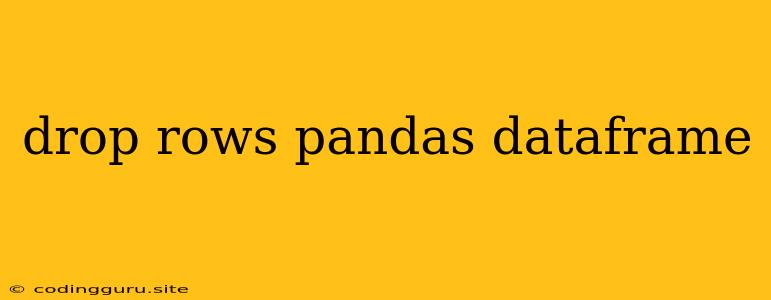How to Drop Rows from a Pandas DataFrame
Pandas is a powerful library in Python for data analysis and manipulation. One of its most common tasks is cleaning and preparing data for analysis. A key part of this process is often dropping unwanted rows from a DataFrame. This can be necessary for many reasons, such as removing duplicates, handling missing data, or filtering based on specific criteria.
Why Would You Need to Drop Rows in a Pandas DataFrame?
There are many situations where dropping rows from a DataFrame is necessary. Here are some common reasons:
- Removing duplicates: You might have duplicate entries in your dataset that you want to remove to avoid bias in your analysis.
- Handling missing data: Sometimes your DataFrame contains rows with missing values (NaNs). You might need to drop these rows if they're not easily imputable or if their presence significantly affects your analysis.
- Filtering based on specific criteria: You may want to select only certain rows based on specific conditions, such as values in a particular column.
Common Methods for Dropping Rows
Pandas provides several methods for dropping rows from a DataFrame:
df.drop(): This is a general-purpose method for dropping rows (or columns) by index label or by position.df.dropna(): This method specifically targets rows containing missing values (NaNs).- Boolean Indexing: You can create a boolean mask based on conditions and use this to select and drop rows.
Examples
Let's look at some examples of dropping rows using different methods:
1. Dropping Rows by Index:
import pandas as pd
data = {'Name': ['Alice', 'Bob', 'Charlie', 'David'],
'Age': [25, 30, 28, 22],
'City': ['New York', 'London', 'Paris', 'Tokyo']}
df = pd.DataFrame(data)
print(df)
# Drop row with index label 2
df_dropped = df.drop(index=2)
print(df_dropped)
2. Dropping Rows by Position:
# Drop the second row (index 1)
df_dropped = df.drop(index=1)
print(df_dropped)
3. Dropping Rows with Missing Values:
# Create a DataFrame with missing values
data = {'Name': ['Alice', 'Bob', 'Charlie', 'David'],
'Age': [25, 30, None, 22],
'City': ['New York', 'London', None, 'Tokyo']}
df = pd.DataFrame(data)
print(df)
# Drop rows with any missing values
df_dropped = df.dropna()
print(df_dropped)
# Drop rows only if all values are missing
df_dropped = df.dropna(how='all')
print(df_dropped)
4. Dropping Rows Based on Conditions (Boolean Indexing):
# Drop rows where 'Age' is greater than 25
df_dropped = df[df['Age'] <= 25]
print(df_dropped)
5. Dropping Duplicate Rows:
# Create a DataFrame with duplicate rows
data = {'Name': ['Alice', 'Bob', 'Charlie', 'David', 'Bob'],
'Age': [25, 30, 28, 22, 30],
'City': ['New York', 'London', 'Paris', 'Tokyo', 'London']}
df = pd.DataFrame(data)
print(df)
# Drop duplicate rows based on all columns
df_dropped = df.drop_duplicates()
print(df_dropped)
# Drop duplicate rows based on specific columns
df_dropped = df.drop_duplicates(subset=['Name', 'Age'])
print(df_dropped)
Key Points to Remember
inplace=True: When using thedrop()method, you can use theinplace=Trueparameter to modify the DataFrame directly instead of creating a new one.axis=0: This parameter is used to specify that you want to drop rows (as opposed to columns, which would beaxis=1).howandthreshparameters: These parameters are relevant fordf.dropna()and allow for more fine-grained control over how missing values are handled.
Conclusion
Dropping rows from a Pandas DataFrame is a crucial step in data preparation. By understanding the different methods and their parameters, you can effectively remove unwanted data and ensure your analysis is based on clean and reliable information. Remember to choose the method that best suits your specific needs and to always check your results to confirm that the correct rows have been dropped.
